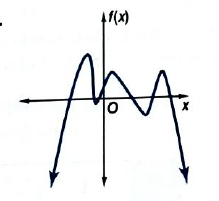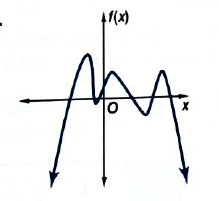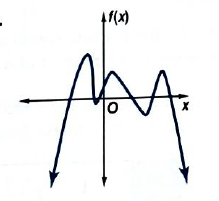
(a)
To find:the end behaviour of the graph.
(a)
Answer to Problem 59STP
Explanation of Solution
Given:

Concept used:
For an even degree function the end behaviour will be same direction.
For an odd degree function the end behaviour will be in different direction.
If
Then curve will be open ward.
Or
The end point of the curve will be:
up and up for even.
Down and up for odd.
If
Then curve will be down ward.
The end point of the curve will be:
Down and down for even.
Up and down for odd.
Calculation:
The curve equation is
The degree is
End points lies on the same direction and there will be
As
Hence,
(b)
To find:whether the graph represent even degree or an odd degree function.
(b)
Answer to Problem 59STP
The graph is even degree function.
Explanation of Solution
Given:

Concept used:
For an even degree function the end behaviour will be same direction.
For an odd degree function the end behaviour will be in different direction.
If number of cut in the x-axis or zeroes in the axis is even then the function is even degree function.
and if number of cut in the x-axis or zeroes in the axis is odd then the function is odd degree function.
Calculation:
According to the given:
Since the graph cut the x-axis at
Hence, the graph is even degree function.
(c)
To find:the number of real zeroes in the graph.
(c)
Answer to Problem 59STP
There is
Explanation of Solution
Given:

Concept used:
The number of real zeroes is the number of intersections with x-axis by the curve or number cut made by the curve on x-axis.
Calculation:
Zeroes can be calculated as the number of cut in the x-axis by curve.
Since there is
Therefore, there will be
Hence, there is
Chapter 6 Solutions
Algebra 2
Additional Math Textbook Solutions
Algebra and Trigonometry (6th Edition)
Pre-Algebra Student Edition
Calculus: Early Transcendentals (2nd Edition)
A First Course in Probability (10th Edition)
College Algebra with Modeling & Visualization (5th Edition)
- Solve the following system of equations: 50x+20y=1800 10x+3y=300arrow_forward> > > we are hiring Salesforce Admin Location: Remote Key Responsibilities: Administer Salesforce Sales & Revenue Cloud (CPQ & Billing) Configure workflows, validation rules & dashboards Automate processes using Flows & Process Builder Collaborate with Sales, Finance & Marketing teams Manage user roles & security Apply: Hr@forcecraver.comarrow_forwardAnswer this questionarrow_forward
- 1. vector projection. Assume, ER1001 and you know the following: ||||=4, 7=-0.5.7. For each of the following, explicitly compute the value. འབ (a) (b) (c) (d) answer. Explicitly compute ||y7||. Explain your answer. Explicitly compute the cosine similarity of and y. Explain your Explicitly compute (x, y). Explain your answer. Find the projection of onto y and the projection of onto .arrow_forward2. Answer the following questions using vectors u and v. --0-0-0 = find the the cosine similarity and the angle between u and v. འརྒྱ (a) (b) find the scalar projection of u onto v. (c) find the projection of u onto v. (d) (e) (f) find the scalar projection of onto u. find the projection of u onto u. find the projection of u onto and the projection of onto . (Hint: find the inner product and verify the orthogonality)arrow_forwardPlease type out answerarrow_forward
- The function f(x) = log x is transformed to produce g(x) = log (x) – 3. Identify the type of transformation and describe the change. Please type out answerarrow_forwardEach graph below is the graph of a system of three linear equations in three unknowns of the form Ax = b. Determine whether each system has a solution and, if it does, the number of free variables. A. O free variables ✓ B. no solution C. no solution D. no solution E. 1 free variable F. 1 free variablearrow_forwardSolve the following systems of equations and show all work.y = x2 + 3y = x + 5 Please type out answerarrow_forward
 Algebra and Trigonometry (6th Edition)AlgebraISBN:9780134463216Author:Robert F. BlitzerPublisher:PEARSON
Algebra and Trigonometry (6th Edition)AlgebraISBN:9780134463216Author:Robert F. BlitzerPublisher:PEARSON Contemporary Abstract AlgebraAlgebraISBN:9781305657960Author:Joseph GallianPublisher:Cengage Learning
Contemporary Abstract AlgebraAlgebraISBN:9781305657960Author:Joseph GallianPublisher:Cengage Learning Linear Algebra: A Modern IntroductionAlgebraISBN:9781285463247Author:David PoolePublisher:Cengage Learning
Linear Algebra: A Modern IntroductionAlgebraISBN:9781285463247Author:David PoolePublisher:Cengage Learning Algebra And Trigonometry (11th Edition)AlgebraISBN:9780135163078Author:Michael SullivanPublisher:PEARSON
Algebra And Trigonometry (11th Edition)AlgebraISBN:9780135163078Author:Michael SullivanPublisher:PEARSON Introduction to Linear Algebra, Fifth EditionAlgebraISBN:9780980232776Author:Gilbert StrangPublisher:Wellesley-Cambridge Press
Introduction to Linear Algebra, Fifth EditionAlgebraISBN:9780980232776Author:Gilbert StrangPublisher:Wellesley-Cambridge Press College Algebra (Collegiate Math)AlgebraISBN:9780077836344Author:Julie Miller, Donna GerkenPublisher:McGraw-Hill Education
College Algebra (Collegiate Math)AlgebraISBN:9780077836344Author:Julie Miller, Donna GerkenPublisher:McGraw-Hill Education





